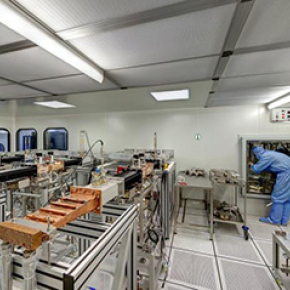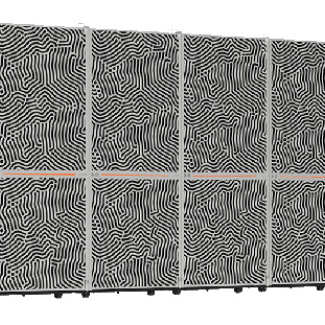
European XFEL: Europe's next-generation free-electron laser
The faster, more powerful European XFEL free-electron laser1 was inaugurated on September 1, 2017, near Hamburg, Germany. By producing ultra-bright, trillion-photon X-ray flashes at a frequency two hundred times greater than the best preexisting free-electron lasers (FELs), this next-generation European instrument will allow scientists to map the atomic relief of viruses, decipher the molecular composition of cells, create 3-D images of the nanoworld, and even film chemical reactions. Eleven countries helped build the XFEL, at a cost of €1.2 billion. The French National Center for Scientific Research (CNRS) and Alternative Energies and Atomic Energy Commission (CEA) both played a leading role in the design and construction of the superconducting electron accelerator at the heart of this new international research facility.
- 1A free-electron laser (FEL) generates photons using electrons that are not bound to atoms. It emits intense, coherent light across a wide range of wavelengths, including microwaves, X-rays, UV, visible light, and infrared. The new European laser specifically produces X-rays.
Since the 1970s, particle accelerators have been used to produce X-rays through synchrotron radiation. This technology is used for structural analysis of materials and was enhanced through the construction of dedicated research facilities—e.g., ESRF and SOLEIL in Grenoble and Saclay, France, respectively. FELs emit ultra-bright (1012 photons), ultra-short (on the order of a femtosecond2
) flashes of almost perfectly coherent (~100%) light,3
opening up new horizons for scientific investigation. The European XFEL, based outside of Hamburg, Germany, uses a superconducting electron accelerator to generate 27,000 ultra-bright X-ray flashes per second—a frequency two hundred times greater than its best FEL predecessors. With a length of 3.4 km, it is also the longest laser in its class.
The European XFEL electron accelerator is a pioneer in the world of light sources as it is the only one to harness superconductivity. It was built by a consortium of European institutes, primarily based in France, Germany, Italy, Poland, Russia, Spain, and Switzerland. France's involvement will include future projects coordinated by the CNRS. But the country is also home to the Orsay-based Laboratoire de l'Accélérateur Linéaire (CNRS / Paris-Sud University), or LAL, which played an important role during the laser's construction. LAL supervised the production and conditioning of all power couplers,4
crucial components of linear particle accelerators. Certain steps in the preparation of the couplers required knowledge transfer benefiting industrial firms, and close cooperation with these companies was necessary to ensure the quality of the finished product. Unique equipment for the mass production of the couplers was installed at the laboratory, allowing for an output of 8 to 10 conditioned couplers per week. The conditioned couplers were then sent to the CEA Institute of Research into the Fundamental Laws of the Universe (Paris-Saclay), or IRFU, for assembly into 103 cryomodules. The CEA completed this integrative task through the transfer of knowledge to the company Alsyom—under the terms of a July 2012 agreement—and the use of a dedicated facility in Saclay. This made it possible to assemble one cryomodule every four days, without sacrificing technical quality. The DESY pilot laboratory in Germany analyzed the performance of the couplers and cryomodules—the fruit of eight years of effort—and its results confirm the technological prowess of the French scientists.
European XFEL emitted its first beam in May 2017. It can now produce light with enough intensity to elucidate structures on nanometric or even atomic scales in a single pulse. Both the duration—on the order of a femtosecond—and the coherence of the light flashes will allow scientists to study the dynamics of biological structures, nano-objects, and chemical reactions in real time. In addition, the laser's exceptional brilliance5
will enable induction and observation of excited states of matter—such as those existing at the core of planets.
For further information :
XFEL and the consortium: https://www.xfel.eu/
Assembly of power couplers: http://irfu.cea.fr/Phocea/Video/index.php?id=296
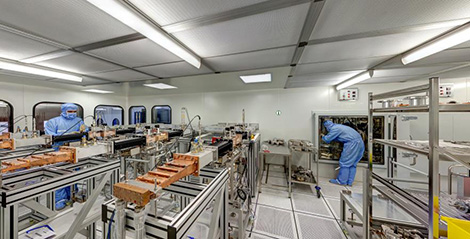
Virtual tour of the XFEL unit at LAL (CNRS / Paris-Sud University):
http://www.visites-virtuelles.u-psud.fr/?s=pano42&s=pano21750&h=-26&v=0&f=90
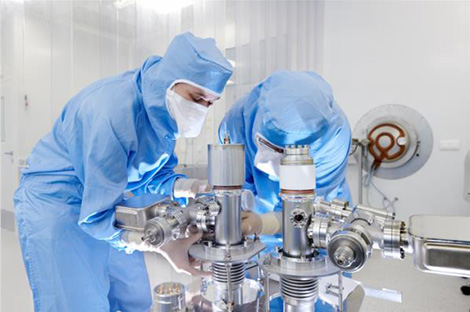
Clean-room assembly of pump units upon reception of couplers at LAL (CNRS / Paris-Sud University).
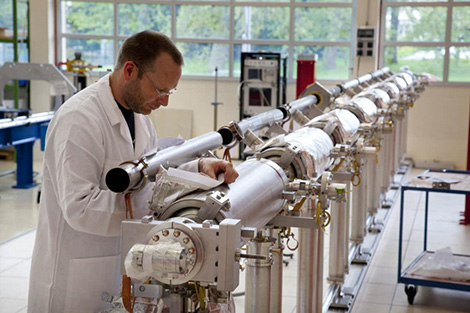
Assembly of cryogenic helium distribution system for series of cavities along XFEL.
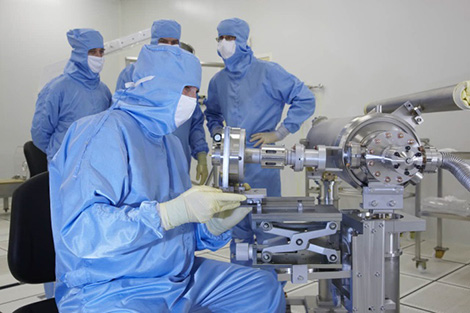
Clean-room assembly of accelerator cavities.
More pictures available at https://media.xfel.eu/XFELmediabank/?l=en&c=16055
- 21 femtosecond (1 fs) = 1 quadrillionth of a second (10-15 s)
- 3 By increasing light coherence, we obtain a more accurate image of how matter is organized.
- 4A total of 850 power couplers were produced: 700 by the European Thales/RI consortium and 150 by the American company CPI.
- 5Number of photons emitted per unit of time, per unit of angular divergence, per unit of cross-sectional area, for a given bandwidth.
